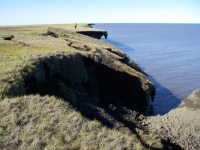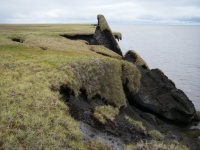Movie:ArcticErosion: Difference between revisions
No edit summary |
No edit summary |
||
| Line 18: | Line 18: | ||
}} | }} | ||
{{Movie description | {{Movie description | ||
|Grade level=Middle (6-8), High (9-12), Under graduate (13-16), Graduate / Professional | |||
|One-line movie description=Time-lapse series of coastal bluff erosion along the Arctic Coast at Drew Point, Beaufort Sea, Alaska | |One-line movie description=Time-lapse series of coastal bluff erosion along the Arctic Coast at Drew Point, Beaufort Sea, Alaska | ||
|Extended movie description=Time-lapse series of coastal bluff erosion along the Arctic Coast at Drew Point, Beaufort Sea, Alaska. Coastal erosion rates exceeding 20 meters per year are being observed along the Arctic Coast, and they are especially high along Alaska’s Beaufort Sea coastline. Comparison of aerial photos and LANDSAT imagery suggest accelerating erosion rates over the last 50 years. Arctic sea ice coverage has been declining dramatically over the last few decades and record September minima were observed in 2007. These observations suggest a causal relationship between sea ice decline and coastal change. The timelapse movies presented here show that the relative roles of thermal and wave energy may be significant. The bluffs consist of silt and have high ice-content. The thawing of the ice-rich bluffs by relatively warm seawater undermines coastal bluffs, leading to topple failures of discrete blocks defined by ice-wedge polygons. The fine-grained nature of these materials does not function as a protective barrier for incoming waves, so there is not a strong negative feedback on erosion rates, so that coastal erosion rates in this setting are likely to increase with continued Arctic warming. | |Extended movie description=Time-lapse series of coastal bluff erosion along the Arctic Coast at Drew Point, Beaufort Sea, Alaska. Coastal erosion rates exceeding 20 meters per year are being observed along the Arctic Coast, and they are especially high along Alaska’s Beaufort Sea coastline. Comparison of aerial photos and LANDSAT imagery suggest accelerating erosion rates over the last 50 years. Arctic sea ice coverage has been declining dramatically over the last few decades and record September minima were observed in 2007. These observations suggest a causal relationship between sea ice decline and coastal change. The timelapse movies presented here show that the relative roles of thermal and wave energy may be significant. The bluffs consist of silt and have high ice-content. The thawing of the ice-rich bluffs by relatively warm seawater undermines coastal bluffs, leading to topple failures of discrete blocks defined by ice-wedge polygons. The fine-grained nature of these materials does not function as a protective barrier for incoming waves, so there is not a strong negative feedback on erosion rates, so that coastal erosion rates in this setting are likely to increase with continued Arctic warming. | ||
| Line 35: | Line 36: | ||
{{Movie references1 | {{Movie references1 | ||
|Key papers on movie if any=Mars, J. S. & Houseknecht, D. W. Quantitative remote sensing study indicates doubling of coastal erosion rate in past 50 yr along a segment of the Arctic coast of Alaska. Geology 35, 583-586 (2007). | |Key papers on movie if any=Mars, J. S. & Houseknecht, D. W. Quantitative remote sensing study indicates doubling of coastal erosion rate in past 50 yr along a segment of the Arctic coast of Alaska. Geology 35, 583-586 (2007). | ||
}} | |||
{{Movie references1 | |||
|Key papers on movie if any=Wobus, C., R.S. Anderson, I. Overeem, N. Matell, G. Clow, F. Urban, 2011. Thermal Erosion of a Permafrost Coastline: Improving Process-Based Models Using Time-Lapse Photography. Journal of Arctic Antarctic and Alpine Research, Vol. 43, No. 3, 2011, pp. 474–484 | |||
}} | |||
{{Movie references1 | |||
|Key papers on movie if any=• Overeem, I., R. S. Anderson, C. Wobus, G. D. Clow, F. E. Urban, N. Matell, publ online 2011. Sea Ice Loss Enhances Wave Action at the Arctic Coast. Geophysical Research Letters, 38, L17503, doi:10.1029/2011GL048681, 2011. | |||
}} | }} | ||
{{Movie references2}} | {{Movie references2}} | ||
Revision as of 07:57, 2 February 2012
Information Page: ArcticErosion
Play Movie
Bluff Erosion in the Arctic
Key Attributes
| Domain: | coastal |
| Keywords: | Coastal Bluff Erosion |
| Model name: | Animation model name |
| Name: | Irina, Overeem |
| Where: | Beaufort Coast, Alaska |
| When: | July 2-28, 2008 |
Short Description
Grade level: Middle (6-8), High (9-12), Under graduate (13-16), Graduate / Professional
Statement: Time-lapse series of coastal bluff erosion along the Arctic Coast at Drew Point, Beaufort Sea, Alaska
Abstract: Time-lapse series of coastal bluff erosion along the Arctic Coast at Drew Point, Beaufort Sea, Alaska. Coastal erosion rates exceeding 20 meters per year are being observed along the Arctic Coast, and they are especially high along Alaska’s Beaufort Sea coastline. Comparison of aerial photos and LANDSAT imagery suggest accelerating erosion rates over the last 50 years. Arctic sea ice coverage has been declining dramatically over the last few decades and record September minima were observed in 2007. These observations suggest a causal relationship between sea ice decline and coastal change. The timelapse movies presented here show that the relative roles of thermal and wave energy may be significant. The bluffs consist of silt and have high ice-content. The thawing of the ice-rich bluffs by relatively warm seawater undermines coastal bluffs, leading to topple failures of discrete blocks defined by ice-wedge polygons. The fine-grained nature of these materials does not function as a protective barrier for incoming waves, so there is not a strong negative feedback on erosion rates, so that coastal erosion rates in this setting are likely to increase with continued Arctic warming.
Theory
Links
Template:Movie references1 Template:Movie references1 Template:Movie references1 Template:Movie references1


